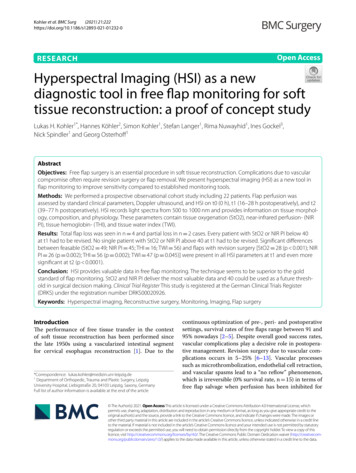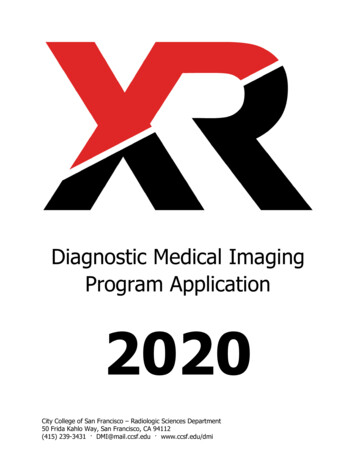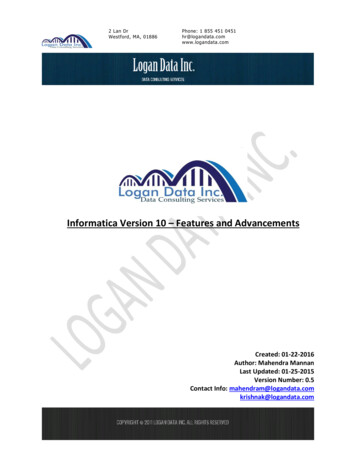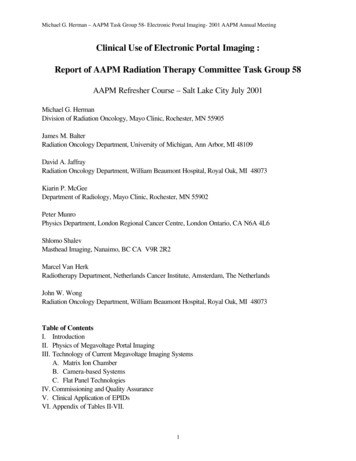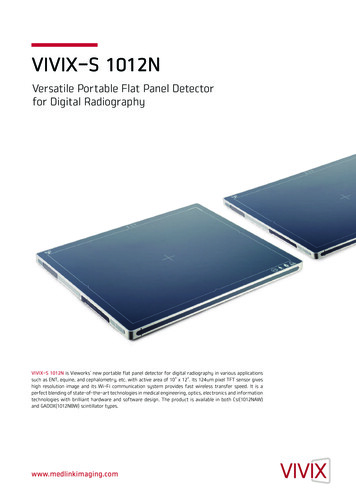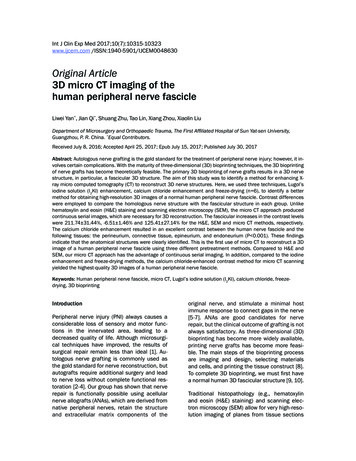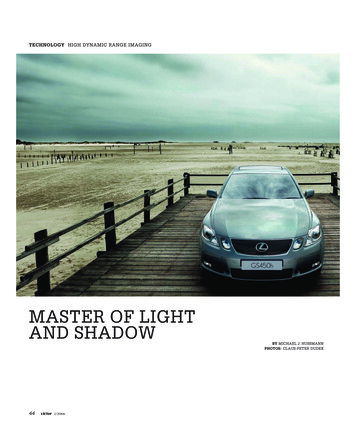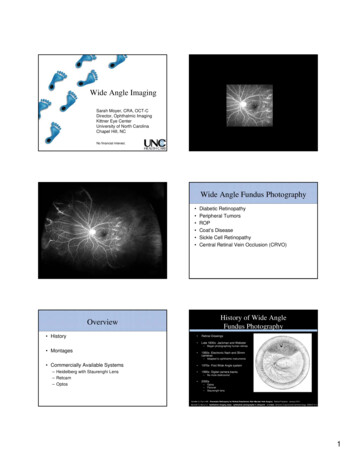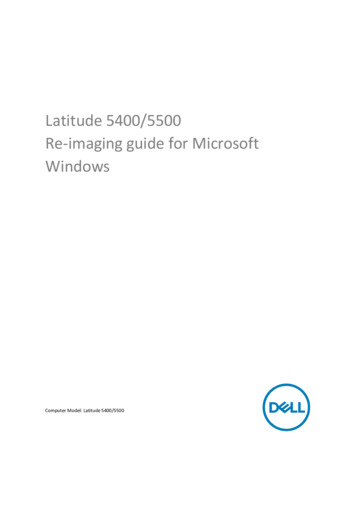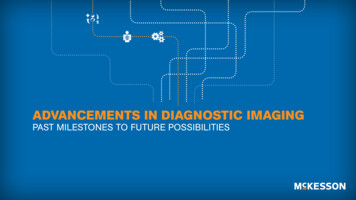
Transcription
ADVANCEMENTS IN DIAGNOSTIC IMAGINGPAST MILESTONES TO FUTURE POSSIBILITIES1 #IMAGINGFUTURE
TABLE OF CONTENTSIntroduction. 3Moving ForwardLooking BackErkan Akyuz. 21Erkan Akyuz. 5Joe Biegel. 6Travis Browning. 7David Chou. 8Don Dennison. 10Sue Johnson. 12Joseph Marion. 13Giles Maskell. 14Jeffrey Mendel. 15Patricia & Jason Salber. 17Leigh S Shuman. 19Joe Biegel. 22Travis Browning. 24David Chou. 25Don Dennison. 26Sue Johnson. 28Joseph Marion. 29Giles Maskell. 30Jeffrey Mendel. 31Patricia & Jason Salber. 33Leigh S Shuman. 35Learn More. 36Thank You. 382 #IMAGINGFUTURE
LOOKING BACK AND MOVING FORWARDInnovation is the key to the future. It has been the driving force behind theadvancements of our industry’s past, and continues to drive us toward better,more efficient, and more patient-centric healthcare practices. Excellence indiagnostic imaging can be the catalyst for providing truly life-changing care.The work done by radiology professionals improves quality of life and driveshealth systems forward. On the following pages, we share insights from theindustry’s best and brightest, celebrating the progress of our past and lookingahead to the possibilities of our future. Read on to see what the experts haveto say about where we’ve been and where we’re going.3 #IMAGINGFUTURE
LOOKING BACK: REMEMBERING ANDCELEBRATING PAST PROGRESS4 #IMAGINGFUTURE
DICOM AND IHE STANDARDSDEVELOPMENTErkan AkyuzPresidentImaging andWorkflow SolutionsMcKesson TechnologySolutionsBeyond the inventions of the CT and MRI machines that create images, the developmentof DICOM and IHE standards are arguably among the most significant advancements indiagnostic imaging. Through standards we are able to open the lines of communication andcollaboration by providing reliable protocols for the integration of imaging data from differentdevices and systems at both the technical and workflow level. These standards allow forvarious systems to be integrated in an efficient and repeatable way that is independent fromthe participating vendors. The DICOM and IHE standards really helped medical imaging leadthe pack in the world of healthcare IT.@ErkanAAkyuz5 #IMAGINGFUTURE
ADAPTIVE IMAGE LOADING ANDWORKFLOW IMPROVEMENTSJoe BiegelVice PresidentCorporate Strategy andBusiness DevelopmentMcKesson TechnologySolutions@JoeImagingSeveral major historical advancements come to mind. In 1994, at the RSNA annualconference, DICOM 3.0 proved that diagnostic images could be stored and transmittedindependently of proprietary modality vendor barriers. Soon after, RIS/PACS workflow wasdramatically improved with the advent of the Mitra Broker.Support for high-volume, multi-slice CT data stressed early stage PACS architectures, butadvances, such as adaptive image loading, enabled multimodality PACS to improve the levelof diagnostic performance with any and all image data that was produced.In more recent times, the integration of digital breast tomosynthesis into the core PACSenvironment serves as an example of how advanced visualization methods have becomecore to the PACS workflow.6 #IMAGINGFUTURE
APPLICATION AND SOFTWAREINTEGRATIONTravis Browning, MDI believe the biggest advancement in PACS has been the ability to integrate with otherapplications: dictation software (efficiency and safety), post-processing applications (3-Dand others), peer review software, and the EMR (a significant improvement in facilitating theradiologist to be in the chart while reading exams).Radiologist andAssociate ProfessorUT Southwestern7 #IMAGINGFUTURE
IMAGE EXCHANGE IMPROVEMENTSThe industry has come a long way in terms of interoperability. The ability to exchange imagesbetween various vendors is easier than before, but there are still some pain points since it isstill not perfect. We will continue to see strides in this area, and the healthcare community islooking forward to full integration among all PACS vendors.David ChouHealthcare CIO@dchou1107“The ability to exchangeimages between various vendorsis easier than before.”TWEET THIS8 #IMAGINGFUTURE
DIGITAL IMAGING IT TOOLSThe evolution of medical imaging, from the first x-ray to today’s advanced digital modalities,has contributed to enormous advances in medicine, saving millions of lives.Don DennisonPresidentDon K DennisonSolutions Inc.@DonKDennisonThe advent of digital imaging IT tools, like PACS, delivered incredible productivity andaccessibility. Results that took a week to deliver a generation ago are available in minutes.Images evolved from 2D projections to 3D volumes, along with multi-modality fusion anddynamic motion. Yesterday’s science fiction became science reality.As diagnostic images are now digital, and are increasingly consolidated and indexed in largesystems, like multi-facility PACS or VNA, and patient’s information is available in the EMR, newopportunities lie ahead.“Yesterday’s science fictionbecame science reality.”TWEET THIS9 #IMAGINGFUTURE
USER FRIENDLY PACSI think back to our first PACS system and it was so difficult to use and difficult to sign in. It wasnothing compared to what we have now. They’re now much more customer and user friendly.There’s always room for improvement, but a lot has been done to make it easier to find things,like measurement tools. Those, and other built-in features, have gotten so much better.Sue JohnsonPACS ManagerMankato Clinic, Ltd.10 #IMAGINGFUTURE
DIGITAL MODALITIESAND PACS ADVANCEMENTJoseph MarionConsultant & PrincipalHealthcare IntegrationStrategies LLCThe advent of digital modalities, led by CT, CR and ultrasound, were probably the majorimpetus to bring about the advancement of PACS. The early practice of converting digitalimages to film fit with the then-current infrastructure of film-based reading, but created adichotomy in terms of managing images. Many facilities treated the film as the final image,and only kept the digital content for a fixed period of time.@HCInformatics11 #IMAGINGFUTURE
IMAGE MANIPULATION ANDSHORTER ACQUISITION TIMESGiles Maskell, MDPresidentThe Royal Collegeof RadiologistsFrom the perspective of a clinical radiologist, the advances in radiology in the past 100years have been astonishing with new imaging modalities, ever increasing image quality andshorter acquisition times.The advent of digital imaging brought a revolution in our ability to manipulate, transmit andstore medical images, and that revolution is still in progress. We still have a way to go inmanaging the balance between free transfer of images and proper information governance.@RCRadiologists12 #IMAGINGFUTURE
BROADSCALE INTEGRATIONACROSS FUNCTIONSJeffrey Mendel, MDRadiologist andRadiologic ImagingConsultantTufts@jbmcanIntegration in the broadest sense is the single best digital imaging achievement of the past,be it VR, 3D processing, EMR, etc. You can often sit in one place and perform every radiologyfunction except procedures.“You can often sit in oneplace and perform every radiologyfunction except procedures.”TWEET THIS13 #IMAGINGFUTURE
CT, MRI AND ULTRASOUNDPatricia Salber, MDCEOHealth Tech Hatch@DocweighsinJason Salber, MDPrivate PracticeRadiologistSt. Alphonsus HospitalThe three biggest game changers in radiology over the past 100 years have been CT, MRIand ultrasound. Prior to the introduction of CT, the best way to know what was going oninside the body was surgical exploration. MRI has allowed better soft tissue resolution,particularly of the brain, spine, and joints. Finally, ultrasound makes our list because of itsease of use, lack of radiation exposure, and its portability. Ultrasound is getting better, faster,cheaper, and that is a good thing.“Ultrasound is getting better, faster,cheaper, and that is a good thing.”TWEET THIS@JasonSalber14 #IMAGINGFUTURE
PACS-EMR INTEGRATIONLeigh S. Shuman, MDRadiologistLancaster RadiologyAssociatesAs someone who has been fortunate enough to have PACS-EMR integration for four years, Ifeel this has been the most significant improvement in the interpretation of imaging studiessince the coming of PACS. Being able to quickly get to the relevant clinical information (well,maybe not quickly, but at least having a shot at getting there) opens up the potential toactually be clinically relevant.Gone are the days of wishing you could just see the chart to understand what is going on.Actually, those days aren’t gone, since a significant fraction of the patients we read imageson have their clinical information somewhere other than on our EMR.15 #IMAGINGFUTURE
MOVING FORWARD: CONSIDERINGFUTURE POSSIBILITIES16 #IMAGINGFUTURE
UNIVERSAL INTEROPERABILITYErkan AkyuzPresidentImaging andWorkflow SolutionsMcKesson TechnologySolutions@ErkanAAkyuzAs healthcare organizations continue to consolidate, sharing imaging data alongside clinical datawithin and between institutions will become commonplace. As we shift to person-centric care,the future holds the opportunity to achieve ubiquitous interoperability where physicians can tapinto a nationwide network of hospitals and clinics providing real-time, broad access to all of anindividual’s relevant clinical data.The new standard of diagnostic care will be one based on value and dependent upon flexible qualityand communication workflow, and an enterprise worklist driven by clinical and business logic.Widespread use of mobile platforms will make collaboration easier than ever. Clinicians will makefaster and more accurate clinical decisions by integrating, analyzing, and filtering patient informationfrom multiple sources and making it available in the radiologist cockpit.“As we shift to person-centric care,the future holds the opportunity to achieveubiquitous interoperability.”TWEET THIS17 #IMAGINGFUTURE
QUALITY WORKFLOW TOOLSOne area of significant near-term progress has been in deploying integrated quality workflowtools that have the potential to improve both quality and collaboration.Joe BiegelVice PresidentCorporate Strategy andBusiness DevelopmentMcKesson TechnologySolutions@JoeImagingIn the next few years, one area that is likely to see rapid advancement is the use of deep learningmethods that enable predictive analytics to dramatically change the diagnostic process. Thenotion of having a data service “crawl” through volumes of clinical data to provide radiologistshighly relevant collateral aids and specific protocol recommendations will become commonplace.These methods will do many of the routine (error prone) tasks now performed by radiologists.This will not “replace the radiologist,” but will both reduce human error and enable radiologists tofocus on higher level cognitive tasks that support diagnostic workflows.“Having a data service ‘crawl’ through volumesof clinical data will become commonplace.”TWEET THIS18 #IMAGINGFUTURE
STRUCTURED REPORTINGTravis Browning, MDRadiologist andAssociate ProfessorUT SouthwesternI think the biggest advancement will be methodologies for structured reporting (either withtraditional reports or structured annotation) which can facilitate electronic post-processing ofthe diagnostic interpretation for population management, clinical decision support, follow-upreminders, patient tracking, and evaluation of effectiveness of system process changes andother quality initiatives.I believe that as integration between PACS and the EMR becomes more robust, we willapproach a state where a third-party dictation client is unnecessary. The method ofinteracting with images will create the structured elements, either within the PACS (to createthe report to feed the EMR) or through individual elements of information sent from the PACS(and assembled in the EMR).19 #IMAGINGFUTURE
ENTERPRISE WEB VIEWERSThere are a lot of discussions in the market on creating an enterprise web viewer that canwork with all images. I do believe we are due for this soon, and there are a lot of vendorsworking on this currently. Once we have an enterprise web viewer, I think we will see a shiftin the market and it will be interesting to see what happens to the future of PACS.David ChouHealthcare CIO@dchou110720 #IMAGINGFUTURE
AUTOMATION ANDPREDICTIVE ALGORITHMSDon DennisonPresidentDon K DennisonSolutions Inc.@DonKDennisonThe availability of clinical information to correlate with imaging information allows a more accuratediagnosis. Combined with evidence generated by traditional studies, or by analytics of large sets ofclinical data, computers with sophisticated predictive algorithms will become increasingly capableof diagnosing conditions, predicting outcomes and recommending treatment for patients.As image processing advances, automated characterization of findings within imaging data will alsoallow more rapidly available and consistent structured findings. Statistical evidence can be used toestablish automated rules for additional appropriate testing to be conducted.The more algorithms are tuned to deal with specific conditions and diseases, the more personalizedthe medicine will become.“Predictive algorithms will become increasinglycapable of diagnosing conditions.”TWEET THIS21 #IMAGINGFUTURE
ADVANCED IMAGE SHARINGIn the near future, I think the advancements will be in image sharing and the availability ofimages, all following HIPAA’s portability act. I also really feel PACS is going to start being theplace where everyone’s images are stored. We’re starting to see this in our clinic already.Sue JohnsonPACS ManagerMankato Clinic, Ltd.We’re going to be a one-stop-shop for images, and whether they’re jpeg or another filetype won’t matter. I don’t know that it’s necessarily the best use of PACS, but I think it’sunderstandable because providers don’t want to sign-in to a separate application to getrelevant information. This is going to be triggering a lot of similar changes.22 #IMAGINGFUTURE
ADVANCED VISUALIZATION AND STORAGEContinued advancement in advanced visualization will be a major driving force in diagnosticimaging and PACS. New imaging techniques will produce ever-increasing amounts of data,which may best be viewed as three-dimensional objects.Joseph MarionConsultant & PrincipalHealthcare IntegrationStrategies LLC@HCInformaticsAdvancements in computational and storage technology will enable better management ofthese larger data sets, as will the advent of cloud-based storage alternatives. Cloud-basedstorage will foster greater collaboration by providing better study accessibility.Smarter consumers and the advent of alternative healthcare structures, such as the ACO(Accountable Care Organization), will place further pressure on study accessibility acrossentities and more personal control over study content by the patient.Similarly, changing healthcare practices may mean greater integration of patient records.This may result in more applications of Health Information Exchanges (HIE), as well asfurther consolidation of information systems infrastructure.The ability to access images today via smart phones or tablets will continue to trend withadvancements in commercial technology.23 #IMAGINGFUTURE
VOLUME OF DATA SOLUTIONSGiles Maskell, MDPresidentThe Royal College ofRadiologists@RCRadiologistsThe next problem for us is the volume of data. Only a few years ago, a radiologist might haveviewed a few hundred images in a day’s work, whereas that figure can now be into the tensof thousands. This trend will continue and we will only cope with it through the developmentof a sophisticated machine learning algorithms, which can present data to the humaninterpreter in a format which can be reviewed and analyzed in a more time-efficient way.I don’t worry about computers taking over our jobs, but we must use the advances in artificialintelligence to enhance our ability to diagnose and manage disease, recognizing that wemust use the available technology for the maximum benefit of patients.24 #IMAGINGFUTURE
INTELLIGENT INTEGRATIONNear future advances must be in intelligent integration. This may be in sophisticated analysisof EMR data via artificial intelligence, selection of relevant priors, preprocessing, or retrieval ofremote (outside) studies.Jeffrey Mendel, MDRadiologist andRadiologic ImagingConsultantTuftsIt may also be in the more mundane (but perhaps more vital) integration of being able to easilycontrol and assign data elements created by image processing, technologist measurements,and voice elements, to various outputs (reports, critical results, tabular data in PACS or otherprocessing functions). Our struggle among the mouse, keyboard and microphone is the resultof having to handle multiple interfaces and contexts to complete our work.@jbmcan“Near future advances must bein intelligent integration.”TWEET THIS25 #IMAGINGFUTURE
ARTIFICIAL INTELLIGENCE ANDPATTERN RECOGNITIONSome futurists have predicted the demise of specialties based on pattern recognition, such as dermatologyand radiology. But we think advances in artificial intelligence will change the practice of radiology.Patricia Salber, MDCEOHealth Tech Hatch@DocweighsinJason Salber, MDPrivate PracticeRadiologistSt. Alphonsus Hospital@JasonSalberComputer learning algorithms are being developed that will provide an initial interpretation of images. Imagesread as normal with a very high degree of certainty will not need a human over-read. Outliers, those imagesnot considered normal by the algorithms, will be referred to radiologists for expert interpretation.Sophisticated computers will integrate with PACS, EMRs, and other medical databases, so that patternrecognition can be correlated with
McKesson Technology Solutions @ErkanAAkyuz. 6 #IMAGINGFUTURE . and others), peer review software, and the EMR (a significant improvement in facilitating the . the report to feed the EMR) or through individual elements of information sent from the PACS (and assembled in the
